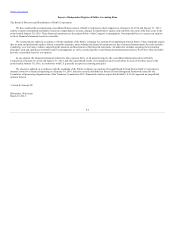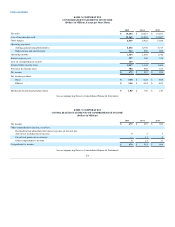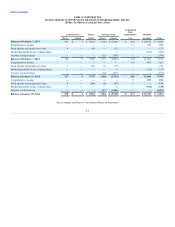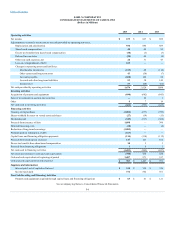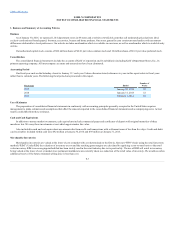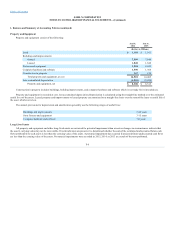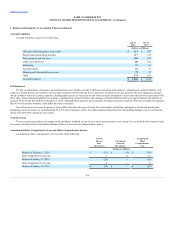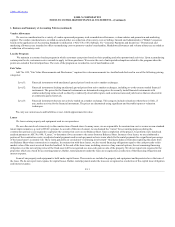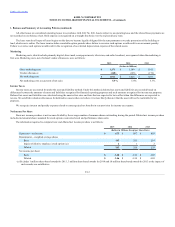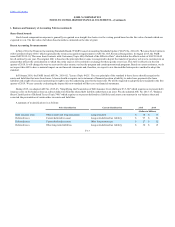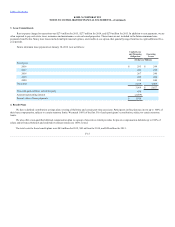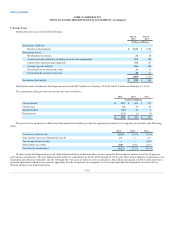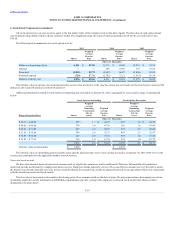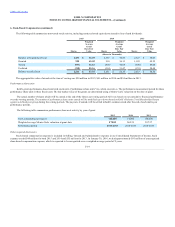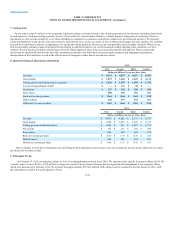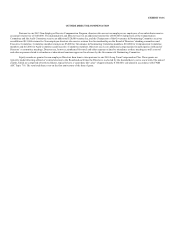Kohl's 2015 Annual Report Download - page 50
Download and view the complete annual report
Please find page 50 of the 2015 Kohl's annual report below. You can navigate through the pages in the report by either clicking on the pages listed below, or by using the keyword search tool below to find specific information within the annual report.
Table of Contents
We receive consideration for a variety of vendor-sponsored programs, such as markdown allowances, volume rebates and promotion and marketing
support. The vendor consideration is recorded as earned either as a reduction of inventory costs or Selling, General and Administrative (“SG&A”) expenses
based on the application of Accounting Standards Codification (“ASC”) No. 605, Subtopic 50, “Customer Payments and Incentives.” Promotional and
marketing allowances are intended to offset our marketing costs to promote vendors’ merchandise. Markdown allowances and volume rebates are recorded as
a reduction of inventory costs.
We maintain a customer loyalty program in which customers earn points based on their spending and other promotional activities. Upon accumulating
certain point levels, customers receive rewards to apply to future purchases. We accrue the cost of anticipated redemptions related to the program when the
points are earned at the initial purchase. The costs of the program are recorded in cost of merchandise sold.
ASC No. 820, “Fair Value Measurements and Disclosures,” requires fair value measurements be classified and disclosed in one of the following pricing
categories:
Level 1: Financial instruments with unadjusted, quoted prices listed on active market exchanges.
Level 2:
Financial instruments lacking unadjusted, quoted prices from active market exchanges, including over-the-counter traded financial
instruments. The prices for the financial instruments are determined using prices for recently traded financial instruments with
similar underlying terms as well as directly or indirectly observable inputs, such as interest rates and yield curves that are observable
at commonly quoted intervals.
Level 3:
Financial instruments that are not actively traded on a market exchange. This category includes situations where there is little, if
any, market activity for the financial instrument. The prices are determined using significant unobservable inputs or valuation
techniques.
We carry our current assets and liabilities at cost, which approximate fair value.
We lease certain property and equipment used in our operations.
We are often involved extensively in the construction of leased stores. In many cases, we are responsible for construction cost over runs or non-standard
tenant improvements (e.g. roof or HVAC systems). As a result of this involvement, we are deemed the “owner” for accounting purposes during the
construction period, so are required to capitalize the construction costs on our Balance Sheet. Upon completion of the project, we perform a sale-leaseback
analysis pursuant to ASC No. 840, “Leases,” to determine if we can remove the assets from our Balance Sheet. In many of our leases, we are reimbursed a
portion of the construction costs via adjusted rental payments and/or cash payments or have terms which fix the rental payments for a significant percentage
of the leased asset’s economic life. These items generally are considered “continuing involvement” which precludes us from derecognizing the assets from
our Balance Sheet when construction is complete. In conjunction with these leases, we also record financing obligations equal to the cash proceeds or fair
market value of the assets received from the landlord. At the end of the lease term, including exercise of any renewal options, the net remaining financing
obligation over the net carrying value of the fixed asset will be recognized as a non-cash gain on sale of the property. We do not report rent expense for the
properties which are owned for accounting purposes. Rather, rental payments under the lease are recognized as a reduction of the financing obligation and
interest expense.
Some of our property and equipment is held under capital leases. These assets are included in property and equipment and depreciated over the term of
the lease. We do not report rent expense for capital leases. Rather, rental payments under the lease are recognized as a reduction of the capital lease obligation
and interest expense.
F-11



